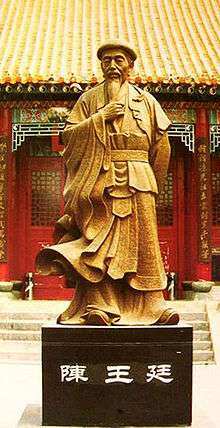Chen Wangting
Chen Wangting (1580–1660) was a Ming Dynasty general who founded Chen-style t'ai chi ch'uan, one of the five major styles of the popular Chinese martial art. Sometimes called Chen Wang Ting or Zouting, he devised the Chen family-style of t'ai chi ch'uan in his home of Chenjiagou, Wenxian county, Henan province after he retired there following the fall of the Ming Dynasty.
| 陈王庭 Chen Wangting | |
|---|---|
 Statue of Chen Wangting | |
| Born | 1580 Chenjiagou, Henan, China |
| Died | 1660 (aged 79–80) |
| Other names | Chen Zouting |
| Nationality | Chinese |
| Style | Chen-style taijiquan (founder of Chen-style) |
| Notable students | Chen Suole (陈所乐), Chen Ruxin (陈汝信) |
| Chen Wangting | |||||||
|---|---|---|---|---|---|---|---|
| Chinese | 陈王庭 | ||||||
| |||||||
| Chen Zouting | |||||||
| Chinese | 陈奏庭 | ||||||
| |||||||
Military career
During the Ming Dynasty, Chen served as Commander of the Wen County garrison, and was distinguished for his protection of merchant caravans in Henan and Shandong.[1] After the Ming Dynasty ended and the reign of the Qing Dynasty began, Chen's military career was effectively over, and he retired to the family settlement.
Influence on t'ai chi ch'uan
Whether or not Chen invented the earliest form of t'ai chi ch'uan is in dispute. Traditional folklore and many lineages name the semi-mythical figure of Zhang Sanfeng, a Taoist monk, as the progenitor of the art.
Two widely documented theories of Chen's martial arts work exist: the first is that he learnt his arts from Wang Zongyue and the Wudang tradition developed by Zhang Sanfeng.[2] The second theory — the one accepted by the Chen family, and supported by historical evidence[3] — is that he combined his previous military experience and the theories of Jingluo and Daoyin with the popular teachings of Qi Jiguang.[4] His complete work contained five smaller sets of forms, a 108-move Long Fist routine, and a Cannon Fist routine. Chen is also credited with the invention of the first push hands exercises.[1] Chen also practiced a few Shaolin forms, and some historians postulate that Shaolin arts also had a significant influence on his t'ai chi, though none of the Taoist influences on Chen family t'ai chi exist in the Shaolin tradition.[2]
Chen Wangting's next well-known successor was the 14th generation Chen Changxing (1771–1853), who was the direct teacher of the founder of Yang-style tai chi chuan: Yang Luchan.
T'ai chi ch'uan lineage tree with Chen-style focus
References
- Gaffney, David; Davidine Siaw-Voon Sim (2001). Chen style taijiquan. North Atlantic Books. ISBN 978-1-55643-377-1.
- Kiew Kit, Wong (2002). The Complete Book of Tai Chi Chuan: A Comprehensive Guide to the Principles and Practice. Tuttle Publishing. ISBN 978-0-8048-3440-7.
- Henning, Stanley (1994). "Ignorance, Legend and Taijiquan". Journal of the Chen Style Taijiquan Research Association of Hawaii. 2 (3). Archived from the original on 2010-01-01. Retrieved 2009-11-23.
- Guang Yi, Ren (2003). Taijiquan: Chen Taiji 38 Form and Applications. Tuttle Publishing. ISBN 978-0-8048-3526-8.